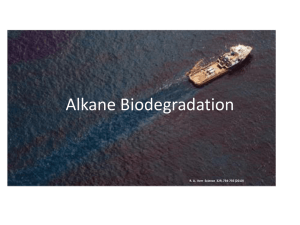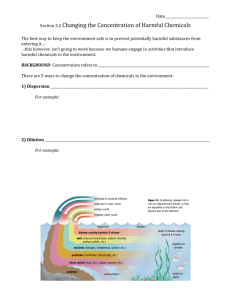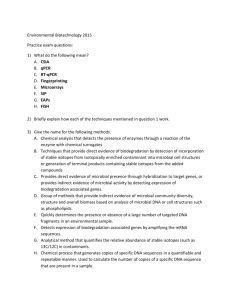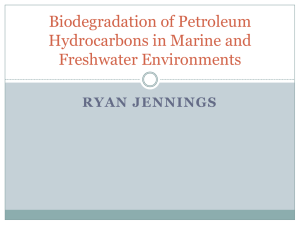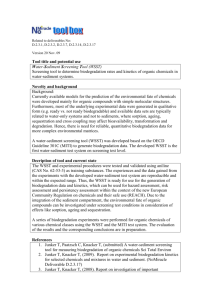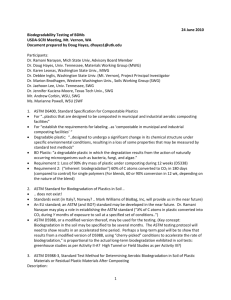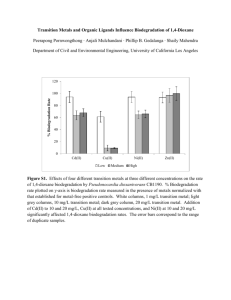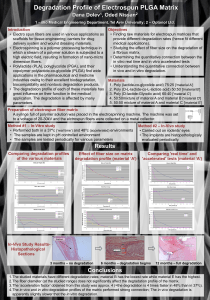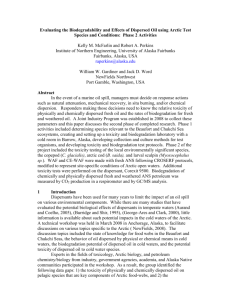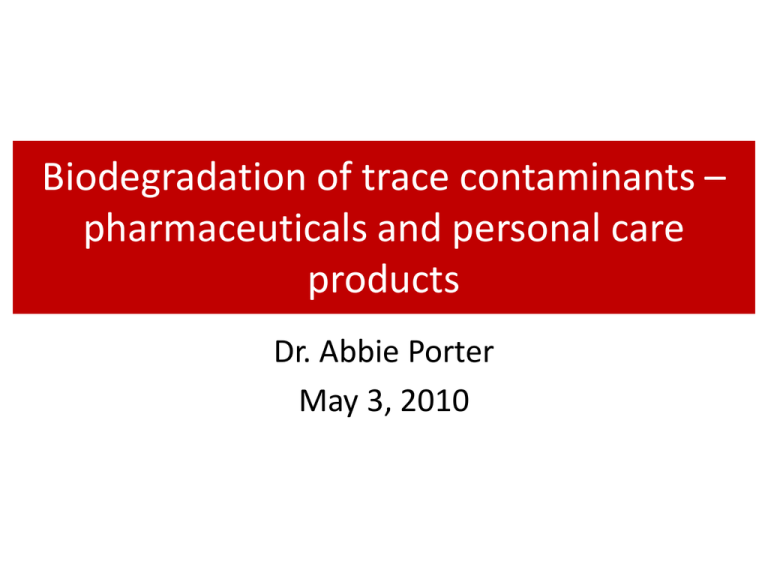
Biodegradation of trace contaminants –
pharmaceuticals and personal care
products
Dr. Abbie Porter
May 3, 2010
Outline
• Discuss abundance of these compounds in the
environment
• Overview of bacterial degradation
• Specific pathways and how they relate to
model aromatic degradation pathways
• Predicting biodegradability
What are PPCPs?
• PPCPs are Pharmaceutical and Personal Care
Products.
• Personal care products include products used for
personal hygiene
• Classified by use, not structure
• Antimicrobials, fragrances,
surfactants
Entry into the environment
• PCPs enter wastewater treatment plants (WWTP) as
components of gray water.
• Pharmaceuticals are also components of the waste
stream, but may have been modified via conjugation
after being ingested.
• While there is removal of these compounds during
the wastewater treatment process, it may not be
complete, which results in environmental release
with the treated water
• Constant use = continued release
PPCP environmental abundance
• Top 5 contaminants
included:
– DEET (N, Ndiethyltoluamide)
– Caffeine
– Triclosan
– 4-nonylphenol
• Concentrations ranged parts
per trillion to parts per
billion
Kolpin et al. 2002
Factors related to PPCP environmental
influx
• Removal in the WWTP
– Abiotic – photolysis/photodegradation
– Biotic – microbial (bacterial and fungal) degradation
– Sorption to biosolids
Factors related to PPCP environmental
influx
WWTP parameters that might have an effect on
biodegradation
1. Temperature
2. Hydraulic retention time
3. Solids retention time
–
–
–
–
Some microbes have a slower growth rate
May require a period of adaptation before degradation
Gene induction
More easily utilized substrates must be removed first
Factors related to PPCP environmental
presence
Environmental parameters that might have an effect on
biodegradation
1. Temperature
2. O2 availability
3. Availability of alternate electron acceptors
4. Acclimation of indigenous microbial
population
Toxicology concerns: endocrine
disruption
• Definition: interference
with endocrine system.
Estrogenic exposure:
– Mimic hormones
– Block hormones
– Cause hormone production at
inappropriate times
– Stimulate overproduction of
hormones
Focus today: estrogen
mimicking compounds
*not always visually obvious, usually
expression of certain female
biomarkers (proteins associated
with egg production)
Environmental estrogens
• Weak binding to estrogen
receptor
• Environmentally relevant
concentrations
• Synergistic effects - additive
Estradiol
Nonylphenol
Effects resulting from
estrogen exposure
• Feminization of male trout –
intersexual individuals
• Changes in sex ratio to
female dominant
• Reduced hatching rates
(fish)
Fate of antimicrobials
• Compounds: triclosan and triclocarban
• Toxicity: possible endocrine disruption activity
• Persistence: One study found triclosan in sediment cores dating
back >30 years (Singer et al. 2002)
• Triclosan can be degraded aerobically (Hay et al., 2001), but not as
readily anaerobically
• Triclocarban can be degraded anaerobically (Miller et al., 2008) but
not as readily aerobically.
Cl
Cl
HO
O
Triclosan
Cl
Triclocarban
Fate of synthetic musks
• Trade names Galaxolide (HHCB) and Tonalide (AHTN), HHCB is most
commonly used
• Use: fragrance compounds
• Toxicity: have shown both estrogenic and estrogen-blocking effects
C H3
H3C
C H3
H3C
C H3
C H3
O
H3C
O
H3C
C H3
H3C
H3C
C H3
HHCB
AHTN
C H3
Estrogens
Anoxic
Estrogens
• 17α-ethynylestradiol (EE2) is a component of birth control pills
• Some report EE2 as more recalcitrant than E1, E2, or E3, but there
are isolates able to metablize it (strain JCR5)
• May be co-metabolized with E1, E2, or E3.
Model of aromatic degradation
Aromatic catabolism
• Common features: mono- or dioxygenation to
activate the ring
• Formation of catechol or substituted catechols
• Ring cleavage: either ortho or meta
Annu. Rev. Microbiol. 1996. 50:553-590
DEET
• Chemical name: N,N-diethyl-m-toluamide
• Use: insect repellent
• Strain: Pseudomonas putida DTB
DEET
3-methylbenzoate 3-methylcatechol 2-hydroxy-6-oxo-hepta2,4-dienoate
diethylamine
Ibuprofen
• Ibuprofen is the 3rd most widely used pharmaceutical in the world.
• Chemical name: 2-(4-isobutylphenyl)-propionic acid
• Use: analgesic, anti-inflammatory frequently found in the
environment, but readily degraded
• Strain: Sphingomonas sp. Ibu-2
Ibuprofen Ibuprofen-CoA
Isobutylcatechol
Alkylphenol polyethoxylates (APE)
• Nonionic surfactants
• Mostly used in agricultural and industrial
processes, but about 15% of the total
production goes to household use (cleaners,
PCPs)
• Have been banned in the EU
APE degradation - aerobic
O
O
OH
O
O
n
Polyethoxylate
O
O
OH
O
OH O
O
n1
2
OH
OR
Di-ethoxylate
Mono-ethoxylate
APE degradation - anaerobic
O
O
OH
O
OH
O
O
O
O
n
O
O
OH
OH
OH
nn-2
1
X
Continued input of APE parent compounds and lack of alkylphenol removal leads
to accumulation under anaerobic conditions
Alkylphenols
• Octylphenol (1 isomer) and nonylphenol (>22
isomers)
• Use: metabolites of alkylphenol polyethoxylates
• Toxicity: mimic estrogen
• Strains: Sphingomonas sp. TTNP3, Sphingobium
xenophagum Bayram, and Sphingomonas sp. PWE1
Hypothesized pathway
OH
OH
OH
OH
LapKLMNOP
LapB
COOCHO
COOH
COOH
COOH
a.
b.
+
O
c.
OH
COOH
OH
Ortho Cleavage
OH
OH
O
COOH
CH O
HOC
Meta Cleavage
+
COOH
Degradation is isomer dependent
OH
• NP isomers with low
amounts of branching
were co-metabolically
transformed
b.
OH
HO
c.
OH
a.
O
HO
d.
O
HO
f.
O
OH
e.
HO
g.
O
Degradation via ipso substitution
OP
Hydroquinone 1,2,4-benzenetriol
Examples of ipso substitution
substrates
OH
OH
OH
OP
NP
a.
b.
c.
OH
d.
OH
e.
Bisphenol-A
•
•
•
•
•
Chemical name: Bisphenol A
Use: plasticizer
Toxicity: estrogen mimicking compound
Strain: Sphingomonas sp. TTNP3
Mechanism: ipso substitution
BPA
Hydroquinone
4-(2-hydroxypropan2-yl)phenol
Kolvenbach et al. 2007
Predicting biodegradability
• While PPCPs look different at first, there are structural elements that are
frequently found in common, such as the aromatic ring.
• Based on the literature, it’s possible to make rational hypotheses as to
how the chemicals could be metabolized without having done any
experiments.
• There are programs that have compiled all of the known metabolic
mechanisms in the literature and use that information to predict
reasonable mechanisms for compounds that have not been published yet.
• This can be very useful.
– Keep in mind, experimental data may be more useful that something from an untested
model.
– Bacteria continue to surprise us. The obvious pathway may not always be in use (OP
pathway).
Predicting biodegradability
• Database of published pathways
• Also a feature to examine the probability that a compound might be degraded
through a specific pathway.
Predicting DEET Biodegradation
http://umbbd.msi.umn.edu/predict/index.html
Predicting DEET Biodegradation
Predicting DEET Biodegradation
Predicting OP biodegradation
http://umbbd.msi.umn.edu/predict/
Predicting OP biodegradation
• This pathway is similar to what had
been predicted earlier for OP
biodegradation.
• However, this does not appear to be
the case for OP biodegradation in the
specific Sphingomonas strains studied.
Notes of caution
• The biodegradation prediction function is based on rules
generated from pathways that are in the literature.
• There may be multiple pathways for degradation
• Not all pathways have been identified and are not in the
database.
• While this is useful to provide a starting point for examining
biodegradation, this does not outweigh experimental
observations
– Example: OP biodegradation pathway
Reasons to study PPCP biodegradation
• Environmental persistence
• Possible toxic or endocrine disrupting effects
• Widespread use and continual entry into the
environment
• Unknown metabolites – need a way to track the fate
of these compounds in the environment

